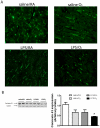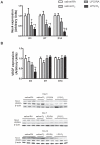Systemic maternal inflammation and neonatal hyperoxia induces remodeling and left ventricular dysfunction in mice
- PMID: 21935422
- PMCID: PMC3173376
- DOI: 10.1371/journal.pone.0024544
Systemic maternal inflammation and neonatal hyperoxia induces remodeling and left ventricular dysfunction in mice
Abstract
Aims: The impact of the neonatal environment on the development of adult cardiovascular disease is poorly understood. Systemic maternal inflammation is linked to growth retardation, preterm birth, and maturation deficits in the developing fetus. Often preterm or small-for-gestational age infants require medical interventions such as oxygen therapy. The long-term pathological consequences of medical interventions on an immature physiology remain unknown. In the present study, we hypothesized that systemic maternal inflammation and neonatal hyperoxia exposure compromise cardiac structure, resulting in LV dysfunction during adulthood.
Methods and results: Pregnant C3H/HeN mice were injected on embryonic day 16 (E16) with LPS (80 µg/kg; i.p.) or saline. Offspring were placed in room air (RA) or 85% O(2) for 14 days and subsequently maintained in RA. Cardiac echocardiography, cardiomyocyte contractility, and molecular analyses were performed. Echocardiography revealed persistent lower left ventricular fractional shortening with greater left ventricular end systolic diameter at 8 weeks in LPS/O(2) than in saline/RA mice. Isolated cardiomyocytes from LPS/O(2) mice had slower rates of contraction and relaxation, and a slower return to baseline length than cardiomyocytes isolated from saline/RA controls. α-/β-MHC ratio was increased and Connexin-43 levels decreased in LPS/O(2) mice at 8 weeks. Nox4 was reduced between day 3 and 14 and capillary density was lower at 8 weeks of life in LPS/O(2) mice.
Conclusion: These results demonstrate that systemic maternal inflammation combined with neonatal hyperoxia exposure induces alterations in cardiac structure and function leading to cardiac failure in adulthood and supports the importance of the intrauterine and neonatal milieu on adult health.
Conflict of interest statement
Figures






References
-
- Barker DJ, Winter PD, Osmond C, Margetts B, Simmonds SJ. Weight in infancy and death from ischaemic heart disease. Lancet. 1989;2:577–580. - PubMed
-
- Berenson GS. Childhood risk factors predict adult risk associated with subclinical cardiovascular disease. The Bogalusa Heart Study. Am J Cardiol. 2002;90:3L–7L. - PubMed
-
- Zieske AW, Malcom GT, Strong JP. Natural history and risk factors of atherosclerosis in children and youth: the PDAY study. Pediatr Pathol Mol Med. 2002;21:213–237. - PubMed
-
- Napoli C, de Nigris F, Welch JS, Calara FB, Stuart RO, et al. Maternal hypercholesterolemia during pregnancy promotes early atherogenesis in LDL receptor-deficient mice and alters aortic gene expression determined by microarray. Circulation. 2002;105:1360–1367. - PubMed
Publication types
MeSH terms
Substances
Grants and funding
LinkOut - more resources
Full Text Sources
Research Materials

